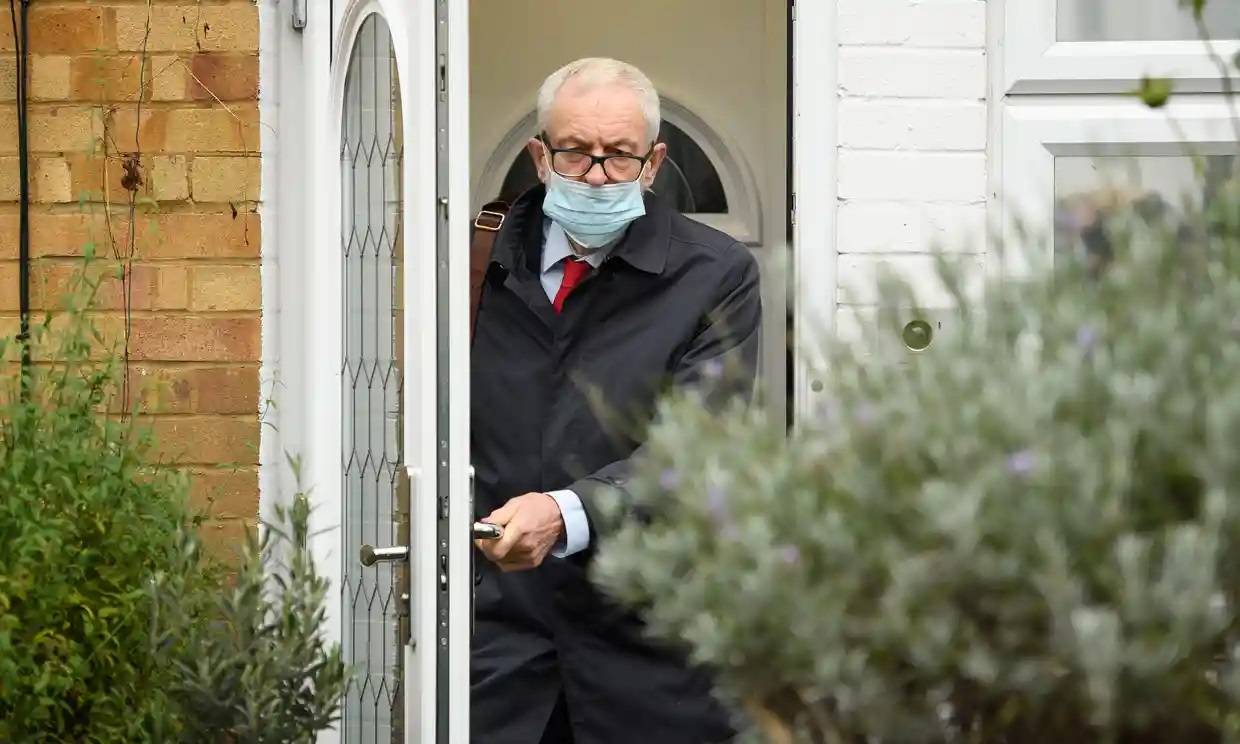
A cartoon that sparked reader complaints
Many readers were angered by a Steve Bell image of the head of the former Labour leader on a plate
On the evening that Jeremy Corbyn was suspended for his response to the Equality and Human Rights Commission’s damning report on antisemitism in the Labour party, the Guardian published a Steve Bell cartoon showing the party leader, Sir Keir Starmer, holding his predecessor’s head on a plate. Borrowing from one of Caravaggio’s several portrayals of the beheading of John the Baptist, it put Starmer in Salome’s place on the canvas while Corbyn’s startled face stared out from the golden platter.
Readers were swift to react. The cartoon drew 32 complaints of using antisemitic imagery, half of which also complained that it was insensitive to depict a decapitation in the wake of recent killings in France. Six readers complained only about offence relating to France, while as many again objected without stating their grounds. Two people did not cite antisemitism but felt strongly that to cast Corbyn as a victim or martyr belittled the conclusions of the EHRC report. Among those who shared personal details with me were Jews, Christians and people of no faith at all
One reader wrote: “Surely you can see that publishing a cartoon presenting Sir Keir Starmer as Salome with the head of Jeremy Corbyn, or John the Baptist to continue the allegory, on a golden platter, as delivered by the Jewish King Herod, was not only deeply offensive, but played upon the very antisemitic tropes that prompted the EHRC’s investigation in the Labour party to begin with?”
“It is extraordinary to me,” said another, “that on a day of such pain for the Jewish community, the culmination of many years of abuse and discrimination from the members of the Labour party, that the Guardian would choose to publish a deeply distasteful cartoon … with the clear antisemitic connotations that that brings (not to mention the lack of taste to have such a cartoon following the horrendous events in France).”
The cartoon also prompted criticism on social media, which was reported by newspapers in the UK and Israel.
Bell strenuously rejected claims that the work was antisemitic, saying he frequently used classical paintings to make a contemporary point, and that the Caravaggio was chosen only as the “best and most effective composition” to convey the head-on-plate image, with neither Jews, Christians nor notions of martyrdom in his contemplation.
“The figures in the painting are Keir Starmer and Jeremy Corbyn, not Salome or John the Baptist. Believe it or not this picture has nothing to do with religion and everything to do with politics,” he said. “Starmer’s hasty and quite shocking decision (if indeed it was his decision rather than that of [the general secretary] David Evans) to suspend the recent leader of the party is both entirely unnecessary (the report did not call for it) and unjustified, in my view, and will ultimately prove counterproductive.”
To have someone’s “head on a plate” is a well-understood idiom to reflect a punishment viewed as severe, and Bell has borrowed from the Caravaggio to express that idea in the past. In 2015, predicting the result of an imminent general election that saw Labour wiped out in Scotland, he had the SNP leader, Nicola Sturgeon, as the executioner handing Ed Miliband’s head to then prime minister, David Cameron.
In the New Testament telling, Salome dances so well for her stepfather, Herod Antipas, that he promises a reward of her choosing. Salome’s mother, Herodias, instructs her to ask for the head of John the Baptist: an act of revenge for his denunciation of her marriage to Herod as incestuous, in violation of Jewish law
Salome has been imbued by artistic treatment down the centuries with more unsavoury qualities than attributed to her by the gospels. But editors were satisfied – I believe, correctly – that the story was not a historical slur, akin for example to the Jewish deicide trope that blames Jews for the killing of Jesus. Neither was the cartoon perceived on its own account to be engaging in classic antisemitic tropes; it was seen as a pared-down visual metaphor for one person’s political beheading of another, without more elaborate meaning.
That reading of the metaphor works for the 2015 cartoon. But context matters. I do not believe Bell to be antisemitic or that he intended his Starmer to embody any noxious myth about Jews (“My targets are taken on as individuals,” he said). His stout defence of Corbyn (who was suspended after saying opponents had “dramatically overstated” Labour’s problem with antisemitism) may offend, but it comes within the bounds of opinion. However, using a Jewish biblical figure who conspired against a saint was highly provocative and open to just the kind of interpretations made.
Some readers suggested the cartoon had been rushed to publication without scrutiny. In fact, there was considerable discussion, including with some Jewish colleagues and experts. But I believe that in mapping the biblical, historical and political detail, the bigger picture was lost. Whether John the Baptist is seen as a Jewish prophet killed for his righteousness or as the first Christian martyr, the immediate impression was of Starmer in Salome’s treacherous dancing shoes. I am not surprised that readers were hurt and angered; in fact, it is hard to see how reaching for Christian imagery when addressing antisemitism would turn out well.
The cartoon dismayed others in light of the recent killings in France, with one saying it “went beyond the boundaries of decency”. On the day of publication, three people had been attacked at a church in Nice, one of whom was nearly decapitated, while two weeks earlier a teacher had been beheaded outside his school near Paris. Staff were candid in saying consideration of this resonance had been eclipsed by focus on the biblical reference. Perhaps the fact that Corbyn was seen wide awake in the drawing damped the alarm bell, but it was undoubtedly insensitive timing, and it’s difficult to imagine this would have happened had the killings taken place in the UK. That may not be a comfortable question for a global publisher to ask itself.
• Elisabeth Ribbans is the Guardian and Observer’s global readers’ editor








